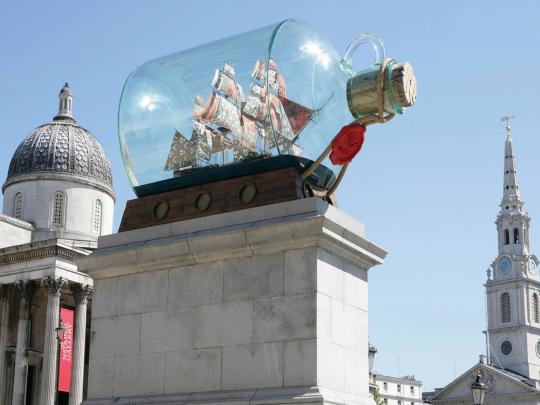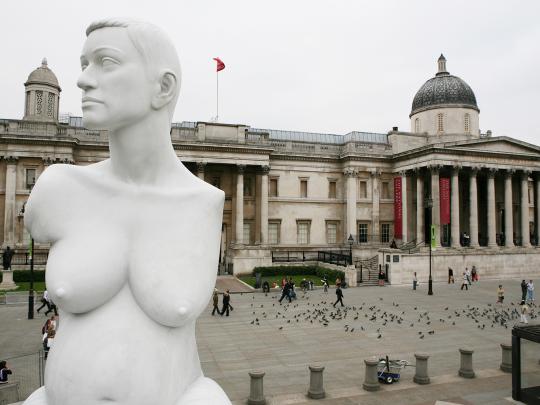
Fourth Plinth: past commissions
The Fourth Plinth is probably the most famous public art commission in the world.
It all began back in 1994 with Prue Leith, then chair of the Royal Society of Arts. She wrote a letter to the Evening Standard suggesting that something should be done about the empty plinth in Trafalgar. This sparked a flurry of public debate. Five years later, it hosted the first artwork, ‘Ecce Homo’ by Mark Wallinger.
Since then, the Mayor of London’s Fourth Plinth programme has invited leading artists to make sculptures for the plinth. These artworks have so far included a bright blue cockerel, a golden rocking horse and even Nelson’s Ship in a Bottle.
The Fourth Plinth has attracted a huge amount of public interest. It has a legion of followers, both in the UK and worldwide. There’s also a Fourth Plinth Schools Awards competition every year. It gives London’s primary and secondary school students the chance to create artworks inspired by the commissions.
'Antelope', Samson Kambalu 2022
On the 28 September 2022, the Fourth Plinth Commission Antelope by Samson Kambalu was unveiled on the Fourth Plinth.
Antelope restages a photograph of Baptist preacher and pan-Africanist John Chilembwe and European missionary John Chorley as a sculpture.
The photograph was taken in 1914 at the opening of Chilembwe’s new church in Nyasaland, now Malawi. Chilembwe has his hat on, defying the colonial rule that forbade Africans from wearing hats in front of white people. A year later, he led an uprising against colonial rule. Chilembwe was killed and his church was destroyed by the colonial police.
On the plinth, Chilembwe is larger than life, while Chorley is life-size. By increasing his scale, the artist elevates Chilembwe and his story, revealing the hidden narratives of underrepresented peoples in the history of the British Empire in Africa, and beyond.
'The Invisible Enemy Should Not Exist', Michael Rakowitz 2018
Michael Rakowitz’s The Invisible Enemy Should Not Exist was unveiled on the Fourth Plinth in London’s Trafalgar Square on Thursday 28 March, by the Mayor of London Sadiq Khan.
The Invisible Enemy Should Not Exist is a project that Rakowitz started in 2006. It attempts to recreate more than 7,000 objects looted from the Iraq Museum in 2003 or destroyed at archaeological sites across the country in the aftermath of the war. For the Fourth Plinth Rakowitz has recreated the Lamassu, a winged bull and protective deity that stood at the entrance to Nergal Gate of Nineveh (near modern day Mosul) from c 700 B.C, until it was destroyed by ISIS in 2015. It will be the 12th work to appear on the Fourth Plinth since the commissioning programme began in 1998, and will be on the plinth until March 2020.
The reconstructions in The Invisible Enemy are made from recycled food packaging, similar to the reliefs at the base of Nelson’s Column being made from canons salvaged from the wreck of HMS Royal George. The Lamassu is made of 10,500 empty Iraqi date syrup cans, representative of a once-renowned industry decimated by the Iraq Wars.

'Really Good', David Shrigley 2016
Really Good was cast in bronze with the same dark patina as the other statues in the Square, the comic extension of the thumb bringing it up to ten metres in height. Shrigley's ambition is that this will become a self-fulfilling prophecy; that things considered 'bad', such as the economy, the weather and society, will benefit from a change of consensus towards positivity.
Shrigley's daily tirade of satirical vignettes takes the British tradition of satire into three and four dimensions. In his drawings and animations protagonists express their dark impulses and are subject to the violence and irrationality of life, while his sculptures are often jokes in 3-D form, reflecting the absurdity of contemporary society.
David Shrigley was born in 1968 in Macclesfield. He lives and works in Glasgow.

‘Gift Horse’, Hans Haacke, 2015
‘Gift Horse’ was a skeletal, riderless horse in bronze. It was based on an etching by George Stubbs, an English painter whose works can be seen in the National Gallery. Tied to the horse’s front leg was an electronic ribbon with a live ticker of the London Stock Exchange. This completed the link between power, money and history. The sculpture directly references the equestrian statue of William IV originally planned for the plinth.

'Hahn/Cock', Katharina Fritsch 2013
‘Hahn/Cock’ was a huge sculpture of a cockerel. Standing almost 5m tall, the vivid blue artwork really stood out in the square. In art, the cockerel is a symbol regeneration, awakening and strength. Fritsch said if reflects our image of ourselves: “people can see themselves, their character, in animals”. The statue was also comment on the masculine character of the square, with its formal equestrian statues and many statues of men.
‘Hahn/Cock’ goes on long term loan to the National Gallery of Art, Washington from the Glenstone Museum on 30 September.

‘Powerless Structures, Fig 101’, Elmgreen & Dragset, 2012
The Fourth Plinth was meant to hold a bronze equestrian statue of King William IV by Sir Charles Barry. It was never installed. Some 170 years later, Elmgreen & Dragset completed the process with their unique take on traditional equestrian statues. ‘Powerless Structures, Fig. 101’ was a golden-bronze sculpture of a boy astride his rocking horse. In situ, the child became a historical hero like the other statues in the square. Instead of acknowledging the heroism of the powerful, the work celebrated the heroism of growing up. As yet, for the boy there is no history to commemorate – only a future to hope for.
‘Powerless Structures, Fig 101’ is now in the Arken Museum of Modern Art, Denmark.

'Nelson’s Ship in a Bottle', Yinka Shonibare CBE, 2010
‘Nelson's Ship in a Bottle’ was a scale (1:30) replica of HMS Victory in a bottle. It was the first commission by a black British artist, and the first to reflect on its setting. Trafalgar Square commemorates the Battle of Trafalgar, and links directly with Nelson’s column. The ship's 37 large sails were made of patterned textiles typical of African dress. They are used to show African identity and independence. The work considers the legacy of British colonialism and its expansion in trade and Empire. This was made possible through the freedom of the seas and the new trade routes that Nelson’s victory provided.
It now has a permanent home at the National Maritime Museum in Greenwich.

'One & Other', Antony Gormley, 2009
‘One & Other’ was a fascinating portrait of the UK in the 21st century. Every hour, 24 hours a day for 100 days, different people stood on the Fourth Plinth. The 2,400 people who took part were chosen at random. Participants used their time on the plinth as they wished – to perform, to demonstrate or simply reflect.
Gormley’s work helped the Fourth Plinth to become a household name. It garnered attention across the world. It even spawned a storyline in BBC Radio 4 drama The Archers and coined a new term, ‘plinther’.

‘Model for a Hotel’, Thomas Schütte, 2007
‘Model for a Hotel’ was a reproduction or scaled up architectural model of a 21 storey building. The base was the same size as the plinth, but the angles of the hotel extended out at strange angles and different heights. That meant that from each side, a different shape and a different context or background was revealed.
The work was made in specially engineered red, yellow and blue Perspex. At the time, it was the first sculpture on the plinth to use bold colour in stark contrast to its surroundings.

‘Alison Lapper Pregnant’, Marc Quinn, 2005
The first Mayor of London commission was a 3.6m tall, 13-tonne Carrara marble figure of the artist Alison Lapper. She was born with phocomelia and has no arms and shortened legs. The sculpture publicly celebrated a different idea of beauty. It asked us to question our narrow view of what is and what isn’t socially acceptable. The sculpture’s presence was also a huge boost for disabled rights in the UK. A huge inflatable version of the sculpture was later a centrepiece of the London 2012 Paralympic Games opening ceremony.

What Happened Next?
Many of the Fourth Plinth commissions live on after they leave the Trafalgar Square: Yinka Shonibare CBE’s Nelson’s Ship in a Bottle now has a permanent home at the National Maritime Museum in Greenwich. Powerless Structures, Fig 101 by Elmgreen & Dragset was acquired by the Arken Museum of Modern Art, Denmark and Katharina Fritsch’s Hahn / Cock is on long term loan to the National Gallery of Art, Washington from the Glenstone Museum, Maryland, USA.
Need a document on this page in an accessible format?
If you use assistive technology (such as a screen reader) and need a version of a PDF or other document on this page in a more accessible format, please get in touch via our online form and tell us which format you need.
It will also help us if you tell us which assistive technology you use. We’ll consider your request and get back to you in 5 working days.